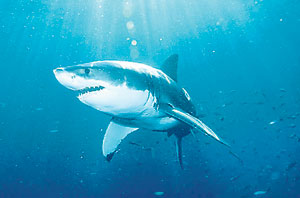The legendary great white shark is far more fearsome in our
imaginations than in
reality. As scientific research on these elusive predators increases, their image as mindless killing machines is beginning to fade.
Of the 100-plus annual shark attacks worldwide, fully one-third to one-half are attributable to great whites. However, most of these are not fatal, and new research finds that great whites, who are
naturally curious, are "sample biting" then releasing their victims rather than preying on humans. It's not a terribly comforting distinction, but it does indicate that humans are not actually on the great white's menu.
Great whites are the largest predatory fish on Earth. They grow to an average of 15 feet in length, though specimens exceeding 20 feet and weighing up to 5,000 pounds (2,268 kilograms) have been recorded.
They have slate-gray upper bodies to blend in with the rocky coastal sea floor, but get their name from their universally white underbellies.
They are streamlined,
torpedo-shaped swimmers with powerful tails that can propel them through the water at speeds of up to 15 miles per hour. They can even leave the water completely, breaching like whales when attacking prey from underneath.
Highly adapted
predators, their mouths are lined with up to 300 serrated, triangular teeth arranged in several rows, and they have an
exceptional sense of smell to detect prey. They even have organs that can sense the tiny electromagnetic fields generated by
animals. Their main prey items include sea lions, seals, small toothed whales, and even sea
turtles and carrion.
Found in cool, coastal waters throughout the world, there is no reliable data on the great white's population. However,
scientists agree that their number is decreasing
precipitously due to
over-fishing and
accidental catching in gill nets, among other factors, and they are listed as an endangered species.
Fast Facts
Type: Fish
Diet: Carnivore
Size: 15 ft (4.6 m) to more than
20 ft (6 m)
Weight: 5,000 lbs (2,268 kg) or more
Group name: School or shoal
Did you know?
Great whites can detect one drop of blood in 25 gallons (100 litres) of water and can sense even tiny amounts of blood in the water up to 3 miles (5 kilometres) away.
Protection status: Endangered
- National Geographic Kids |

